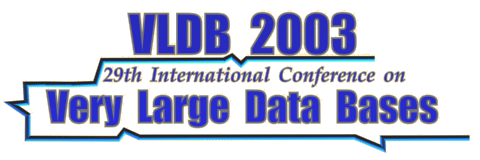|
Abstract
Information
integration provides a competitive advantage to businesses and
is fundamental to on demand computing. It is a strategic area
of investment by software companies today whose goal is to provide
a unified view of the data regardless of differences in data format,
data location and access interfaces, dynamically manage data placement
to match availability, currency and performance requirements,
and provide autonomic features that reduce the burden on IT staffs
for managing complex data architectures. This paper describes
the motivation for integrating information for on demand computing,
explains its requirements, and illustrates its value through usage
scenarios. As shown in the paper, there is still tremendous amount
of research, engineering, and development work needed to make
the information integration vision a reality and it is expected
that software companies will continue to heavily invest in aggressively
pursing the information integration vision.
|
|
About the
speaker
Nelson
Mattos, Ph. D., is one of an elite group of practicing expert
technical executives -- "IBM Distinguished Engineers"
-- recognized not only for their exceptional engineering and programming
in research, development, sales and service, but also for their
anticipated significant future contributions to IBM's growth.
In his current role, director of information integration at the
IBM Silicon Valley Laboratory in San Jose, California, Dr. Mattos
is responsible for establishing IBM's leadership position in the
emerging information integration market. He collaborates with
standards bodies and IBM customers, Business Partners and development
teams to help businesses integrate digital information assets
and leverage the value of those assets across the enterprise.
Capitalizing on his strong research background, Dr. Mattos is
responsible for the strategy, marketing, and development for such
products as DB2 Information Integrator, DiscoveryLink, Replication,
and Relational Connect.
Previously,
as manager of advanced business intelligence and database technology,
Dr. Mattos was the IBM development manager responsible for such
DB2 Universal Database business intelligence solutions as DB2
OLAP Server, DB2 Warehouse Manager (formerly Visual Warehouse
), QMF, Intelligent Miner, Data Replication, DataJoiner, and the
West Coast development of DB2 UDB on Unix and Windows. He also
managed several groups at the IBM Database Technology Institute.
Additionally, Dr. Mattos served not only as chief architect for
DB2's object-relational technologies, but also as leader of the
development of various DB2 Extender products that exploit the
object-relational features of DB2. And he was until recently responsible
for IBM's participation at different standards forums, including
the ANSI SQL committee, the International Organization for Standardization
(ISO) Committee for database, W3C, OMG, and SQLJ. In this capacity,
he contributed extensively to the design of SQL99 through more
than 300 accepted proposals.
Prior
to joining IBM, Dr. Mattos was an associate professor at the University
of Kaiserslautern in Germany, where he was involved in research
on object-oriented and knowledge base management systems and received
a Ph. D in computer science. He also holds bachelor of science
and master of science degrees from the Federal University of Rio
Grande do Sul in Brazil. Dr. Mattos is fluent in four languages,
has published over 75 papers on data base management and related
topics in various magazines and conferences, and is the author
of the book, An Approach to Knowledge Base Management.
|




